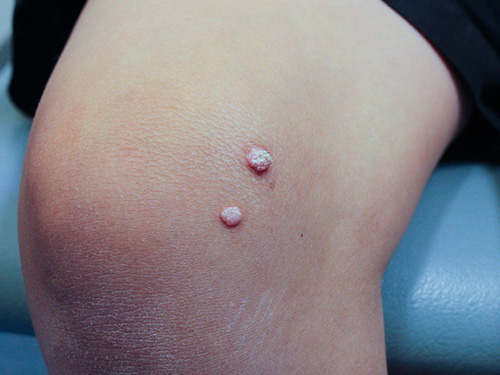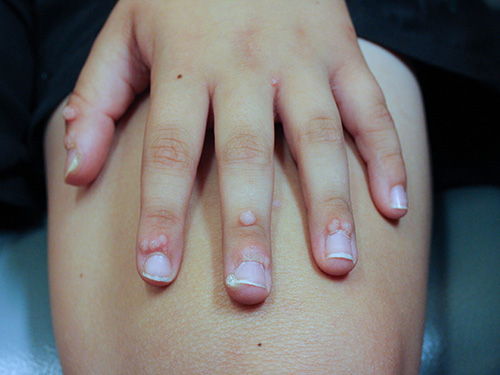Common warts
Common warts (also known as verruca vulgaris) occur often in childhood. They usually occur on the hands, feet and extensor surfaces, and are mainly caused by human papillomavirus (HPV) types 1, 2, 4, 27 and 57. See here for a photo of common warts on the knee.
Common warts usually resolve spontaneously within a few months to 2 years, so in most cases treatment is not needed; however, sometimes treatment is desired by the patient, parent or carer.

The main goal of treatment is to irritate the warts until the body’s immune response overcomes them. A range of treatments is used, but many lack supporting evidence from randomised controlled trials. Repeated treatments are usually required.
Topical salicylic acid and liquid nitrogen cryotherapy have the best evidence for efficacyLeung, 2010Sterling, 2014—topical salicylic acid is less painful, less expensive, and more accessible. Wart-freezing products available over the counter (eg containing dimethyl ether) are considered less effective than liquid nitrogen cryotherapy (because their freezing points are less cold)Nguyen, 2011Sterling, 2014. Surgical excision of warts is not appropriate.
Treatments for warts can potentially lead to scarring. Consider the location of the wart and the potential for scarring from treatments. Consider referral to a dermatologist for warts on cosmetically sensitive areas.
If treatment is desired for common warts, use:
salicylic acid up to 40% w/v, with or without lactic acid, topically, once daily until wart has cleared or for up to 3 months. salicylic acid salicylic acid salicylic acid
Other preparations containing higher concentrations of salicylic acid (eg 60%, as in Upton’s paste1) are used in certain circumstances (eg warts on the soles [plantar warts]).
Before applying salicylic acid each day, advise the patient to protect the healthy skin surrounding the wart by covering it with tape. Pare the surface of the wart with a file, pumice stone or emery board. Ensure the healthy skin is not pared, because this may spread the disease. After applying salicylic acid, cover the wart with occlusive tape.
If there is no response to salicylic acid, liquid nitrogen cryotherapy may be used to freeze isolated warts. Avoid cryotherapy in young children because of the discomfort. The wart must be completely frozen, because otherwise the wart may seed around the margin of the blister (the ‘fairy ring’ effect) and enlarge. Also, over-irritating the wart can cause the virus to spread to the surrounding damaged skin and enlarge. For a patient handout on caring for skin after liquid nitrogen treatment, see Caring for skin after liquid nitrogen treatment.
If the wart persists after multiple sessions of liquid nitrogen cryotherapy, or if the patient has a large number of warts, refer to a dermatologist for specialist treatment options and consideration of other possible diagnoses (eg skin cancers).
Plantar warts (warts occurring on the bottom of the feet) are treated as for common warts, but more aggressive treatment is usually requiredSterling, 2014. Subungual warts (warts occurring under the nail) and periungual warts (warts occurring around the nail or on the cuticle) are also treated as for common warts but care needs to be taken when using liquid nitrogen cryotherapy to avoid damage to the nail plate. See here for a photo of periungual warts.

